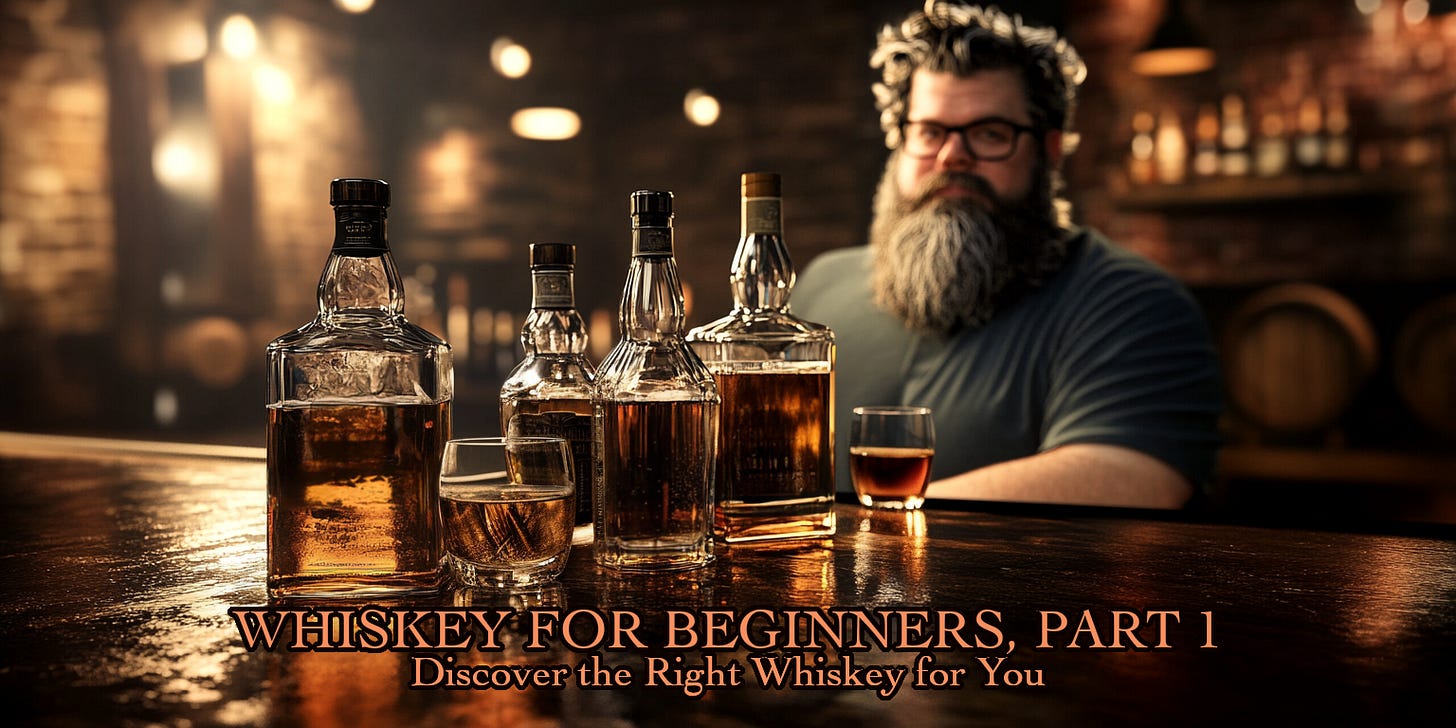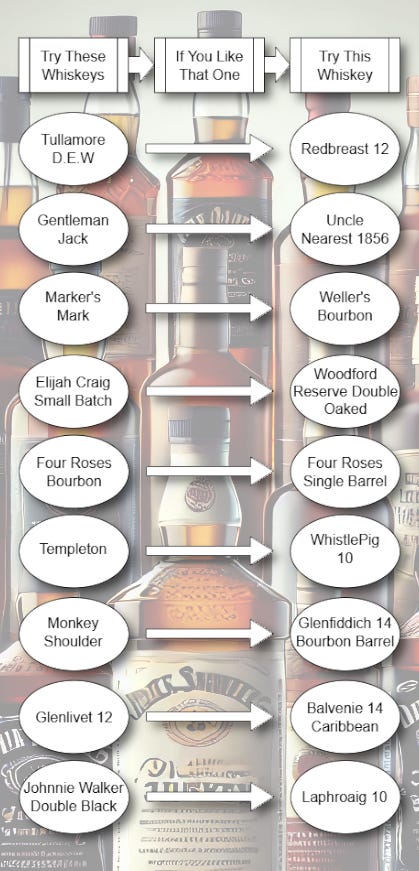"What do you get when you mix grain, water, and yeast together? BREAD. If you were thinking beer, maybe you need to rethink some life choices. But something akin to beer is the base for all whiskeys..." – Paul Hamelink, Paul’s Cigar Lounge.
Choosing your first whiskey can feel overwhelming, especially when you’re staring at shelves lined with bottles of all shapes and sizes. But just like finding the perfect loaf of bread, whiskey is about personal preference and discovering what suits your taste. Whether you're drawn to something sweet and smooth, or bold and spicy, there's a whiskey out there for you. Let’s dive into the world of whiskey to help guide you toward your new favorite pour.
What Exactly Is Whiskey?
Whiskey is a spirit distilled from fermented grain mash, and it’s aged in wooden barrels, typically oak. While the base ingredients—grain, water, and yeast—might seem simple, the variations in grain type, distillation methods, and aging processes create an incredibly diverse range of flavors and styles.
A quick note on spelling: You might see it referred to as “whiskey” or “whisky.” The difference mostly comes down to regional preferences. In the U.S. and Ireland, it’s spelled with an "e"—whiskey—while in Scotland, Canada, and Japan, it’s whisky. No matter how it’s spelled, the process is essentially the same.
Think of whiskey as a broad umbrella term that encompasses many styles. All bourbon is whiskey, but not all whiskey is bourbon—just like how all squares are rectangles, but not all rectangles are squares. Under this umbrella, you’ll find a variety of types, each with their own distinct characteristics.
Whiskey 101: What’s the Difference?
Now that you know what whiskey is, let’s explore the different types. Each whiskey has a unique flavor profile that caters to different palates. Here’s a breakdown of the major types of whiskey and what to expect from each one.
Bourbon
Flavor Profile: Sweet, with notes of caramel, vanilla, and oak.
What to Expect: Bourbon is often a great starting point for beginners because of its sweeter flavor. It's like a soft, buttery brioche bread—rich, smooth, and comforting. If you’re looking for something that’s easy to sip and not too challenging, bourbon is your go-to.
Scotch
Flavor Profile: Ranges from light and fruity to peaty and smoky.
What to Expect: Scotch whisky has a wide spectrum of flavors, but the two main endpoints are light, fruity whiskies and bold, peaty ones. Imagine biting into a sourdough for the lighter, fruitier Scotches, or a dense, dark rye bread for the smoky, peaty varieties. If you like your whiskey with a kick, smoky Scotches might be your jam, while the lighter varieties offer a more delicate experience.
Rye
Flavor Profile: Spicy, with notes of pepper, cinnamon, and sometimes citrus.
What to Expect: Rye whiskey delivers a bolder, spicier experience compared to bourbon. Think of it as the marbled rye of the whiskey world—a mixture of the dark, robust character with the sweeter, softer flavors we’re more comfortable with. In fact, most Rye whiskeys use rye and corn as their two main grains. So you can find some that are almost a bourbon all the way to full-on peppery spice. If you enjoy a little kick and complexity in your drink, rye is worth exploring.
Irish Whiskey
Flavor Profile: Light, smooth, often with hints of honey and vanilla.
What to Expect: Known for its triple distillation process, Irish whiskey is smooth and easy to drink. It's the Wonder Bread of whiskeys—familiar, soft, and versatile. If you're just getting into whiskey and don’t want anything too aggressive, Irish whiskey offers a great entry point.
Tennessee Whiskey
Flavor Profile: Similar to bourbon, but smoother, with notes of charcoal and maple.
What to Expect: Tennessee whiskey undergoes an extra charcoal filtering process, known as the Lincoln County Process, which mellows the flavor even more. Picture a sweet cornbread—soft, slightly sweet, with a back note of corn. This whiskey is perfect for those who want something smooth and mellow, without a lot of bite.
Finding Your Flavor: A Few Tips
Now that you know the basic types of whiskey, how do you find the one that’s right for you? Here are a few tips to guide you:
Start Simple: Begin with a whiskey that has a lower ABV (alcohol by volume). Whiskeys in the 40-45% range are easier to sip and less intense for beginners.
Consider Your Taste Preferences: Do you enjoy bold, strong flavors? If so, try a smoky Scotch or Rye whiskey, which pack a bit more punch. If you prefer something sweeter and smoother, reach for a bourbon or Irish whiskey. But tread carefully, these are generalizations, and all categories have brands that buck the system.
Don’t Be Afraid to Experiment: You won’t know what you like until you try different options. Feel free to keep notes or snap a picture of the whiskeys you enjoy (or really dislike)—just don’t confuse the two! Try whiskey out at a bar, so you can order them by the pour instead of potentially wasting money on a full bottle that you end up not liking. Once you’ve got a few whiskeys you like, show the bartender and ask for new recommendations in the same ballpark.
Take a Flight: Many bars offer whiskey flights, where you can sample small pours of different whiskeys. Ask your bartender to create a flight that explores whiskeys within a similar flavor profile or get adventurous and try a variety across different categories. This is an excellent way to discover which style resonates most with your palate.
Recommended Order to Try
If you’re still unsure where to start, here’s a recommended order to try whiskey, progressing from lighter to more complex flavors. I’ll include a flowchart at the end of this Substack with suggestions of where to go once you find a whiskey you like.
Tullamore D.E.W. – A light and smooth Irish whiskey.
Gentleman Jack – A mellow Tennessee whiskey that transitions well into bourbon.
Maker’s Mark or Elijah Craig – Classic bourbons with a rich, sweet profile.
Four Roses – A bourbon that starts introducing some spice, transitioning to rye.
Templeton Rye – Subtle spice with hints of caramel and honey.
Monkey Shoulder – A smooth, approachable blend that’s perfect for easing into Scotch.
Glenlivet 12 – A light, fruity Scotch, offering a glimpse into the world of single malts.
Johnnie Walker Double Black – A smoky, peaty blend that sets the stage for bolder Scotches.
Once you’ve worked through these, pick your favorite and start exploring other whiskeys within that same category or brand. There’s a whole world of whiskey out there, and these are just the starting points.
Final Thoughts: Why Can’t I Find That One Whiskey?
You may have heard of some popular whiskeys that seem impossible to find on the shelf. The reason? Allocation. Certain brands only produce limited quantities of their high-end bottles, and they’re often distributed to select retailers or sold out quickly. Even some base-level whiskeys can be allocated, meaning they’re in short supply due to high demand. Don’t get too discouraged, though—there are plenty of excellent alternatives that are easier to find and just as enjoyable. When in doubt, ask your local liquor store for a recommendation or keep an eye out for new releases from distilleries you enjoy.




Wonderful, useful advice for anyone interested in whiskey. I’m looking for a similar contribution involving pipes and tobacco.